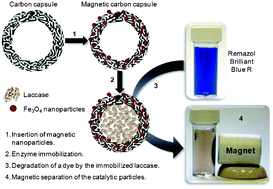Magnetically separable carbon capsules loaded with laccase and their application to dye degradation†
Abstract
A synthetic method to generate uniform sub-micrometric magnetic mesoporous carbon capsules (diameter ∼440 ± 20 nm) made up of ferrite

* Corresponding authors
a
Instituto Nacional del Carbón (CSIC), P.O. Box 73, Oviedo, Spain
E-mail:
abefu@incar.csic.es
Fax: +34 985 297662
Tel: +34 985 119090
A synthetic method to generate uniform sub-micrometric magnetic mesoporous carbon capsules (diameter ∼440 ± 20 nm) made up of ferrite

 Please wait while we load your content...
Something went wrong. Try again?
Please wait while we load your content...
Something went wrong. Try again?
P. Valle-Vigón and A. B. Fuertes, RSC Adv., 2011, 1, 1756 DOI: 10.1039/C1RA00333J
To request permission to reproduce material from this article, please go to the Copyright Clearance Center request page.
If you are an author contributing to an RSC publication, you do not need to request permission provided correct acknowledgement is given.
If you are the author of this article, you do not need to request permission to reproduce figures and diagrams provided correct acknowledgement is given. If you want to reproduce the whole article in a third-party publication (excluding your thesis/dissertation for which permission is not required) please go to the Copyright Clearance Center request page.
Read more about how to correctly acknowledge RSC content.
 Fetching data from CrossRef.
Fetching data from CrossRef.
This may take some time to load.
Loading related content
